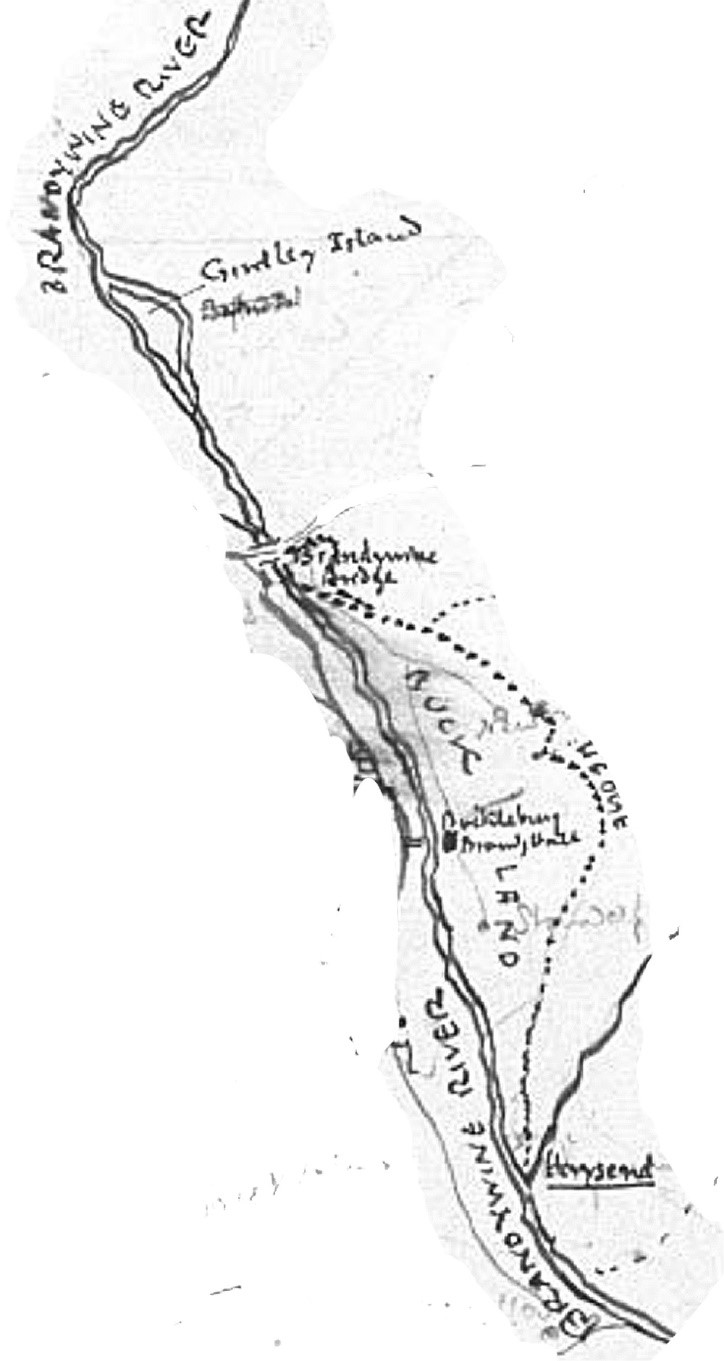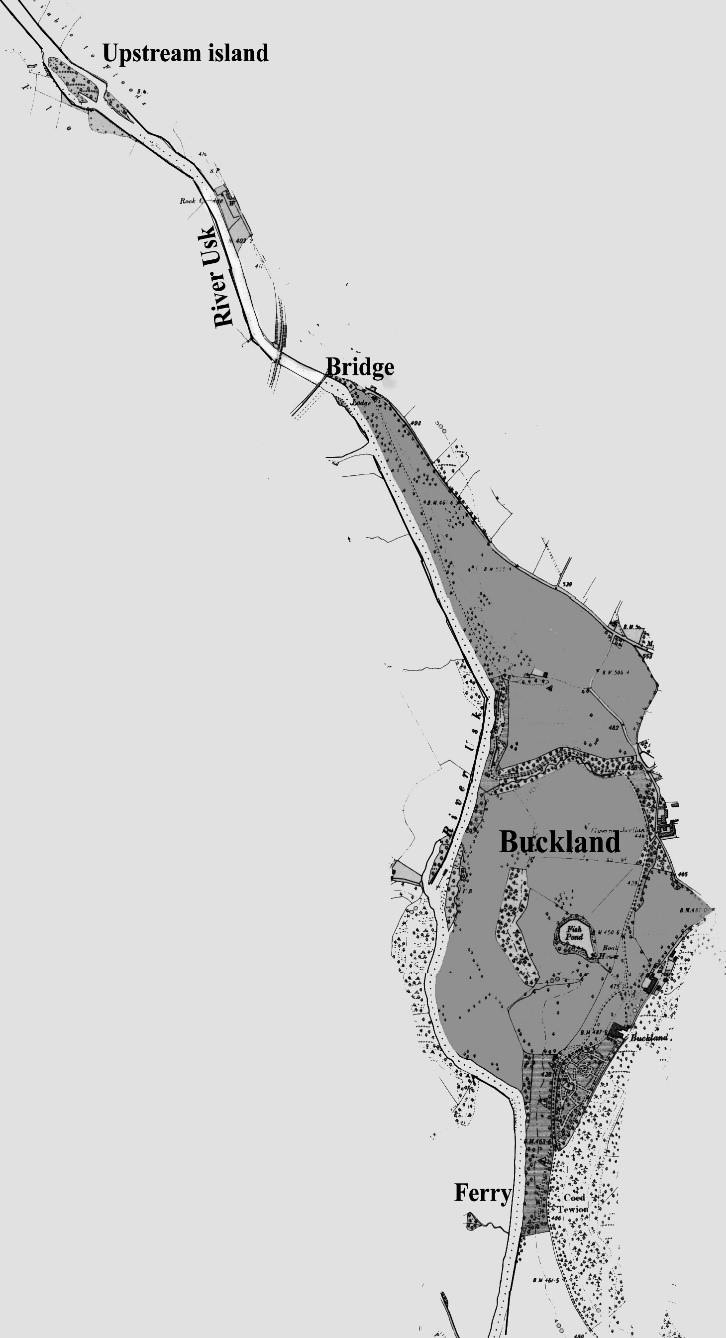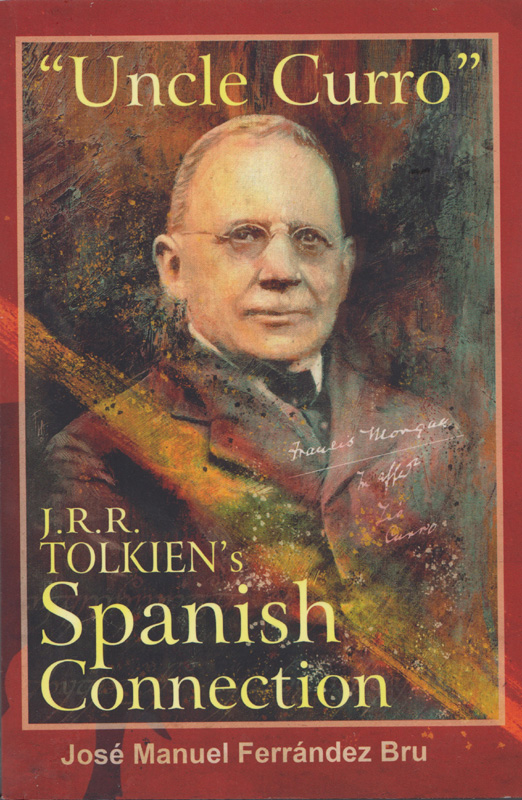|
TOLKIEN
AND THE WINES OF JEREZ
Tolkien's astonishingly inventive mind, allied to vast etymological knowledge,
created a huge range of names, of people, beings, places, plants and things,
names that adorn his legendarium. Some of these, as he sometimes explains,
transmuted into everyday English from his own languages.
The Brandywine River
and the River Usk
The Brandywine River is
first explicitly named in the main text of The Lord of the Rings in
Book 1, Chapter 1, A Long-expected Party:
'And no wonder they're
queer,' put in Daddy Twofoot (the Gaffer's next-door neighbour), 'if they
live on the wrong side of the Brandywine River, and right agin the Old
Forest. That's a dark bad place, if half the tales be true.'
Christopher Tolkien tells
us that a boating accident in an unnamed river in which 'Bilbo' lost his
parents appeared very early in the writing of the LOTR, in the Second
Version of Chapter 1 but was then removed (Tolkien & Tolkien 2015:
19). The boating accident later reappears in a river named as the Brandywine
and is described as follows:
And Mr. Drogo was staying
at Brandy Hall with his father-in-law, old Master Gorbadoc, as he often
did after his marriage (him being partial to his vittles, and old Gorbadoc
keeping a mighty generous table); and he went out boating on the Brandywine
River; and he and his wife were drownded, and poor Mr. Frodo only a child
and all. ''I've heard they went on the water after dinner in the moonlight,'
said Old Noakes; 'and it was Drogo's weight as sunk the boat.'
There are remarkable coincidences
to this tragic event and a real night-time drowning in the River Usk after
a party at Buckland Hall in Breconshire in Wales. This was reported in
a local newspaper and was well-remembered at Buckland decades later when
Father Francis and the two boys are thought to have visited there in 1905
(Hamill-Keays 2018).
Comparison of the course
of the Brandywine as drawn in Tolkien himself in the earliest map 'Part
of the Shire' that survives (Tolkien & Tolkien 2015: Frontispiece),
and the course of the River Usk along a stretch next to the real Buckland
demesne provides compelling evidence that Tolkien used Ordnance Survey
maps to create a template for part of the Brandywine River. It can be
with deduced that he doubtless resorted to OS maps when the plot under
creation brought the Fellowship close to the Bucklebury Ferry, probably
in early 1938 (Hamill-Keays 2019: Genesis). Each Buckland appears as a
bulge of land on the left bank of a south-flowing river, there is a bridge
at each northern end, there is a ferry crossing of each river and there
is an island upstream of each Buckland.

Figure 1. The Brandywine River and Buckland.
Section adapted from the frontispiece of The Return of the Shadow,
The History of the Lord of the Rings. Part 1.

Figure 2. The River Usk and Buckland.
From 1905 Ordnance Survey Sheets XXXIV NE, XXXIV SE and XL NE.
Brandywine and Barandun
Tolkien, explaining derivations of names,
wrote (LOTR: App.F):
The hobbit-names of this river were alterations
of the Elvish Baranduin (accented on and), derived from baran 'golden
brown' and duin '(large) river'. Of Baranduin Brandywine seemed a natural
corruption in modern times. Actually the older hobbit-name was Branda-nîn
'border-water', which would have been more closely rendered by Marchbourn;
but by a jest that had become habitual, referring again to its colour,
at this time the river was usually called Bralda-hîm 'heady ale'.
In performing an etymological loop from Brandywine
in English, through the Elvish Baranduin back to Brandywine, Tolkien demonstrated
his well-known jesting imagination. The question that needs to addressed
is 'Why Brandywine?' Indeed why was the great smial next to Bucklebury-on-the-River
called 'Brandy Hall'. Why is the hobbit family called 'the Brandybucks'?
Brandewijn and Brandy de Jerez
Brandywine is derived from the Dutch for
'distilled wine', brandewijn. (Vogin 1901). The Dutch attachment
to this spiritous product is due to the considerable wine trade that existed
between the one-time Spanish Netherlands and Andalusia from the mid-sixteenth
century onwards. The term holanda (name given to wine spirits of low alcoholic
content used in the production of Brandy de Jerez) is derived from the
name of the country to which most of the exports were destined: Holland.
From there the product was shipped all over the world (CREBJ 2019).
It was at the end of the eighteenth century and early
nineteenth that English merchants, together with Spanish gentlemen with
commercial instincts, were establishing the process of making and aging
Brandy de Jerez and promoting it in major markets of the world together
with sherry, a wine fortified with brandy, that derived its name from
that famous winery town, Jerez. In the twentieth century their products
became world famous.
A major bodega in Andalusia is the House of Osborne. It
was founded in 1772 in Port St Mary (El Puerto de Santa Maria) by an English
trader, Thomas Osborne Mann. In 1851, a daughter of the house, Maria Manuela
Osborne, married Francis Morgan, a merchant from London, with noble Welsh
connections, whose family had moved the administration of their long-established
wine shipping business from Lisbon to Port St Mary in order to exploit
the burgeoning sherry trade. One of the two sons of this marriage was
Francis Xavier Morgan Osborne, the future guardian of Ronald and Hilary
Tolkien, born in 1857. In the 1860s and 1870s many of the family moved
to live in England. Augustus, Francis Xavier's older brother, returned
to Lisbon and from 1898 administered 'Morgan Bros. (Wine Shippers)' in
Andalusia on his own and his brother's behalf. Francis Xavier was thus
better provided for than most of his clerical brethren. He was ordained
as a Catholic priest at the Birmingham Oratory in 1883.
Father Francis, Guardian
Mabel Tolkien, widowed mother of Ronald and
Hilary, died in a diabetic coma in November 1904. Father Francis and her
sister May were by her side. In
her will, Mabel appointed Father Francis to be the guardian of her sons,
Ronald 12 and Hilary 10 . Her conversion to Roman Catholicism in 1900
had set her at odds with her relations; she was anxious for the boys not
to be transduced from the True Faith in which she had found comfort. The
financial support that May's husband had provided ended on her conversion.
Tolkien wrote of the years before her untimely death:
I witnessed (half-comprehending) the heroic
sufferings and early death in extreme poverty of my mother who brought
me into the Church; and received the astonishing charity of Francis Morgan
(Carpenter: Letter 250).
In a letter to one of his sons, Michael,
he commented:
I have met snuffy, stupid, undutiful,
conceited, ignorant, hypocritical, lazy, tipsy, hardhearted, cynical,
mean, grasping, vulgar, snobbish, and even (at a guess) immoral priests
'in the course of my peregrinations'; but for me one Fr. Francis outweighs
them all, and he was an upper-class Welsh-Spaniard Tory, and seemed to
some just a pottering old snob and gossip. He was - and he was not. I
first learned charity and forgiveness from him...(Carpenter: Letter 267).
And in 1972, a year before his own death,
he wrote:
And again I remember after the death of
Fr Francis my 'second father' (at 77 in 1934), saying to C. S. Lewis:
'I feel like a lost survivor into a new alien world after the real world
has passed away.' But of course these griefs however poignant (especially
the first) came in youth with life and work still unfolding. In 1904 we
(Hilary & I) had the sudden miraculous experience of Fr Francis' love
and care and humour ...(Carpenter: Letter 332).
A webpage of the Birmingham Oratory records:
The assets left for the boys' upbringing
were slender but Fr Francis was a man of considerable private means and
he was more than happy to support them in every way necessary (Birmingham
Oratory).
A 2011 review, by E Garcia-Malquez, of José
Manuel Bru's earlier Spanish version of Uncle Curro, in the Cadiz newspaper
La Gaceta comments:
Father Morgan administered the income
of his wards, but seeing that it was not enough, quietly increased it
with the money from the prosperous bodega business in Port St Mary. The
descendants of Tolkien today acknowledge with appreciation that he could
study thanks to the money from the wine of Jerez. (Trans.Author) (Garcia-Malquez)
Tellingly, the reviewer, in commenting the
relationship between English literature and the wine of Jerez adds:
A new page of that relationship is written alongside
Father Francis Xavier Morgan Osborne and J R R Tolkien. The money coming
from the wineries paid for the sophisticated education that enabled the
construction of the complex world of The Lord of the Rings (Trans. Author).
Buckland's Connection to the Lisbon
Wine Trade
Father Francis's great-grandfather was Aaron
Morgan (1742-1818) (Sellers 1899). In 1803 he had formed a partnership
with Charles Dixon in further pursuit of the wine trade in Lisbon (HMSO
1803). A connection has been found between this partnership and of the
Gwynne-Holford family of Buckland: a common history in the Lisbon wine
trade.
Buckland Hall was the family mansion of the
Gwynne-Holford family. They were major landowners in Breconshire and Carmarthenshire.
William Retlaw Williams, a local solicitor and notable historian of Brynore,
Talybont, who, inter alia, published an extensive series of journals,
Old Wales, in the first decade of the twentieth century, researched
the histories of many leading Welsh families. He records that the Holfords
'had been for a considerable time merchant princes in London, being
extensively engaged in the wine business, in Lisbon.' (Williams 1907:
367).
The French invasion of Portugal in 1807, that led to the
Peninsular War, seriously affected the wine shipping business that was
conducted principally by British merchants, Josiah Holford (1726 -1817)
and Aaron Morgan (1742 -1818) being among them. The Master of Buckland
in 1905 was J P W Gwynne-Holford (1832 -1916), Josiah Holford's great-grandson.
The French invasions of Portugal had also caused great distress to the
people, not helped by the British under Wellington laying waste to the
approaches to Lisbon in creating the Lines of Torres Vedras. A committee
of merchants in London was formed to raise funds to alleviate the distress
(De Chabry: Doc. 91). Aaron Morgan and Josiah Holford were both on this
committee, the latter being given responsibilities for foreign correspondence.
Aaron's company contributed £100, Josiah Holford £50.
The wine trade connections above show a wine business
association of the Morgan and Gwynne-Holford families. This, together
with the remarkable similarity of the two tragic drownings, one in the
River Usk, the other in the Brandywine, and the undoubted template of
the Usk used as a model for the latter river, more firmly place Father
Francis and the two boys in the Breconshire Buckland. The only contemporaneous
visit to Wales is that noted by Daniel Grotta:
Shortly after Mabel Tolkien died, Father Morgan, Tolkien
and Hilary went by railway for a fortnight's holiday in Wales (Grotta:
27).
Daniel Grotta does not provide details of his primary
source. After Tolkien's death he had met Charles Carr, Tolkien's scout,
at his lodgings in 21 Merton, Oxford, and his Welsh-speaking wife, Mavis
(Grotta: 151). This may have been the railway journey featured in his
famous English and Welsh lecture (Tolkien 1963). They would have travelled
on the Brecon & Merthyr Junction Railway:
I heard it coming out of the west. It struck at me
in the names on coal-trucks; and drawing nearer, it flickered past on
station-signs, a flash of strange spelling and a hint of a language old
and yet alive.
The Death of Father Francis; Generosity.
Father Francis died at the Birmingham Oratory
on 14th June 1935. No letters between him and Tolkien are available in
the public domain but as Carpenter observes, 'Between 1918 and 1937 few
letters survive…' (Carpenter 1981: Intro.). Tolkien did not attend
his funeral but his son John is believed to have done so (Hammond &
Scull: Note June 1935). Father Francis was buried in the Oratory's graveyard
in Rednal.
This is the kernel of his will:
I give devise and bequeath all and every
my real and personal estate whatsoever and wheresoever unto and to the
use of my brother Augustus Morgan his heirs and whosoever he assigns.
And I appoint him sole executor of this my will and in the event of my
said brother predeceasing me I give devise and bequeath all and every
my real and personal estate whatsoever and wheresoever unto and the use
of the Provost or Superior for the time being of the Oratory Edgbaston
aforesaid when in the like event I appoint him sole executor of this my
will.
The net value of Father Francis's estate
came to £24,901 13s 2d. His brother Augustus predeceased him in
1932 having willed all his possessions to him. This total inheritance
was bequeathed to the care of the Provost of the Birmingham Oratory, Father
Francis Vincent Reade, by the end of August 1935. By a prior private arrangement
Father Francis Morgan had arranged for Ronald and Hilary to each receive
£1000 from this bequest (Confirmed by email from the Oratory 2018).
In 2019 terms this is in excess of £70,000, another example of the
'astonishing charity' of their guardian.
CONCLUSION
In his Foreword to the Second Edition Tolkien
wrote, '…for the composition of The Lord of the Rings went on at
intervals during the years 1936 to 1949…'. Questions as to the reason
the names Brandywine, Brandy Hall and Brandybuck appear in the earliest
chapters have been asked. There can be no doubt that Tolkien benefited
from the 'Wines of Jerez'. Father Francis, as he acknowledged a number
of times, was charitable and generous of both money and time. The magnificent
gift of £1000 in 1935 was a windfall that must have helped J R R's
family in a time of heavy financial demands. It would seem appropriate
for Father Francis's generosity to be memorialised in Brandywine and Brandy
Hall, referring to a spiritous liquour that would have figured largely
in conversations between the boys' guardian and the Master of Buckland
on their meeting. Possibly an avuncular 72-year-old J P W Gwynne-Holford
was the germ for Gorbadoc Brandybuck. One can imagine Father Francis and
JPWG-H raising a crystal glass of fine Osborne Brandy to Aaron and Josiah,
the wine merchants to whom they owed so much, whilst being astutely observed
by a keen pair of young eyes.
|




